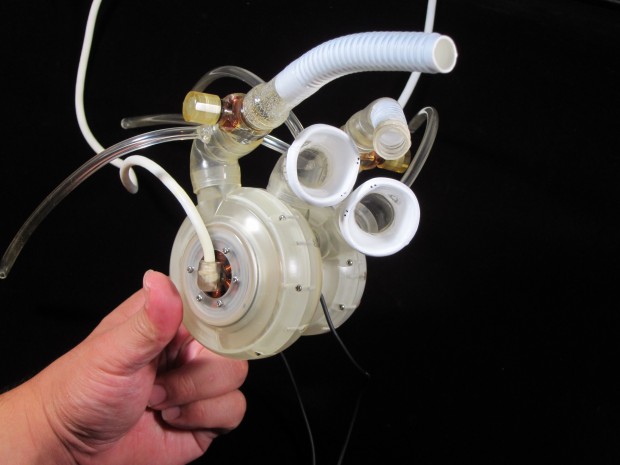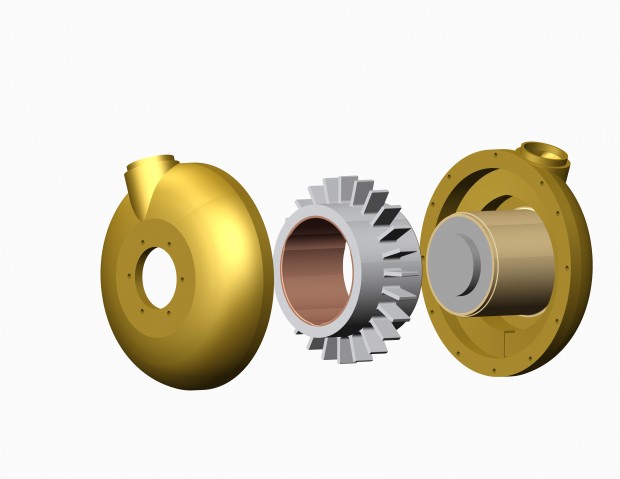
The developed HFTAH is pictured. The HFTAH was designed to have two pump units, left HFP and right HFP. Image courtesy of PTC.
Latest News
May 1, 2015
 The developed HFTAH is pictured. The HFTAH was designed to have two pump units, left HFP and right HFP. Image courtesy of PTC.
The developed HFTAH is pictured. The HFTAH was designed to have two pump units, left HFP and right HFP. Image courtesy of PTC.By Geoff Hedges, PTC
According to the World Health Organization (WHO), almost 20 million people suffer from heart failure worldwide, with 2 million new cases added each year. Many of these patients could benefit from a new heart, but the sad truth is that there simply aren’t enough donors.
So they wait.
Researchers at the Department of Radiology and Biomedical Engineering in the medical school at the University of Tokyo want to change that. In Japan, heart patients wait an average of 981 days for a transplant — that’s more than two and a half years. If the Tokyo group could produce a man-made device that performed just as well as the human organ, they could replace diseased hearts and return patients to good health, or, at the very least keep their circulatory systems running long enough for a donor to be found.
Artificial hearts aren’t new, of course. Doctors have been working with mechanical pumps to keep patients alive during surgery since the 1950s. But up until now, they’ve only been able to replace the heart for a short time — nowhere near the 900+ days it might take to find a new organ.
Using PTC Creo as their design software, the researchers at the University of Tokyo began prototyping and testing a series of innovative mechanical models based on a hydrodynamic levitating impeller pump. Lubricated by the patient’s blood, the design ensures moving parts never touch. The result is a total artificial heart that operates with remarkable efficacy and durability.
How remarkable? In 2008, a goat with one of the team’s total artificial hearts survived 153 days. A pneumatically driven variation kept another goat alive for 532 days, the best performance for the device yet.
Now the researchers say they may be just months away from producing an implantable solution that could completely replace the human heart for much longer than anything in the industry to date.
Bioengineering with PTC Creo
The team at the University of Tokyo uses PTC Creo Parametric to digitally design and model the complex compact heart precisely. By using the extension PTC Creo Simulate, they then test the performance of their 3D models (for example, evaluating fluid dynamics) long before physical prototyping.
“PTC Creo Simulate saves us a lot of time and rework as we identify and solve issues early,” says Isoyama, assistant professor, Department of Biomedical Engineering. “Using the software, we can take an analysis-led design approach, constantly optimizing the model as we get feedback from our digital testing.”
PTC Creo is suited for the fast-changing university environment, as different researchers participate in the project. “I learned PTC Creo fast, as did the other specialists on the team,” says Yurimoto, project member and student doctor.
That low-learning curve is important as numerous team members bring their varied expertise to the project. Plus, PTC Creo gives the team a better understanding of what they are creating.
“It’s a team approach to design, with dedicated specialists working on the mechanical design, sensors, and electronics, and fluid flow,” says Isoyama. “Without a 3D model, you couldn’t visualize the shape, run simulations, and optimize a heart for the performance we’re after.”
Is 2016 the Year of the Heart?
The University of Tokyo researchers recently made an engineering breakthrough that’s led to dramatic improvements in the stability of the hydrodynamic bearing used in the model. That’s one reason they’re now saying 2016 is the year their total artificial heart may become fully realized.
“We’re excited to support the innovative research being done at the University of Tokyo,” says John Stuart, senior vice president, Global Education, PTC. “PTC believes the sustained success of our company, our customers, and society depends on empowering each generation to solve real-world challenges.”
The Total Artificial Heart research is an excellent example of how academic institutions are using PTC’s leading technology solutions not only to prepare future generations for the workforce, but also to make lives better in the very near future.
More Info
Subscribe to our FREE magazine, FREE email newsletters or both!
Latest News







